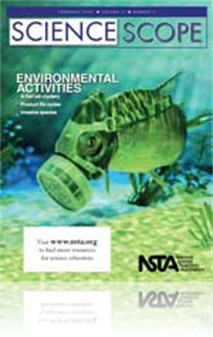All Science Scope resources
Journal Article
After the Bell: Water harvesting II: Working toward being green
As you have read in the previous After the Bell column, water harvesting is a process of diverting and collecting rainwater. One of the main reasons to harvest rainwater is to reduce the demand on local sources of water. The objective of the harves...
Journal Article
Bumpy, Sticky, and Shaky: Nanoscale Science and the Curriculum
Nanoscience, or the study of the world at the size of a billionth of a meter, has the potential to help students see how all of the sciences are related. Behavior of materials at the nanoscale differs from materials at the macroscale. This article in...
Journal Article
Science Sampler: Wade in the water—School, parent, and community collaboration
Real-life science experiences can excite students. Both the American Association for the Advancement of Science (AAAS) and the National Research Council (NRC) stress the importance of hands-on activities that foster inquiry-skill development. One suc...
Journal Article
Scope on the Skies: Deep-sky objects
Beyond the region of our solar system is the rest of the Milky Way galaxy, and of course the rest of the universe. To the amateur astronomer or casual observer, the phrase deep-sky objects is a reference to those dim celestial objects that are beyond...
Journal Article
Tech Trek: The collaborative works of wikis
Wikipedia is part of a new generation of public documents—collectively known as wikis—to which many different writers may make contributions. Due to the collaborative nature of wikis, controversy flares up from time to time about the veracity or ...
Journal Article
Tried and True: Investigating ecosystems in a biobottle
Biobottles are miniature ecosystems made from 2-liter plastic soda bottles. They allow students to explore how organisms in an ecosystem are connected to each other, examine how biotic and abiotic factors influence plant and animal growth and develop...
Journal Article
The Fish Kill Mystery: Using Case Studies in the Middle School Classroom
Case studies are an excellent method for engaging middle school students in the current work of scientists. Students learn to think like scientists as they decide how to investigate the dilemma presented in the case study. This article describes one ...
Journal Article
Scope on Safety: There’s no such thing as a free gift
With shrinking budgets, increasing enrollments, aging equipment, and major advances in technology, donations are one way that science departments can help ends meet. However, many donations can be more trouble than they are worth. To help avoid any s...
Journal Article
How Do Our Actions Affect Water Quantity and Quality?
Water is an essential resource for all living things. How we live on our watershed can impact water quantity and quality. It is important to recognize how humans alter watershed dynamics, but students often find it challenging to visualize watershed ...
Journal Article
There’s More to Light Than Meets the Eye
This investigation was part of a multi-lesson unit that gave students direct experience using increasingly sophisticated tools to make more detailed observations and measurements of light. Through these lessons, students experienced a key aspect of t...
Journal Article
Editor’s Roundtable: At the breaking point
Sobering articles and alarming predictions about the environment appear in magazines, journals, and the media daily. These warnings should not be overlooked and are a call to action for educators. Our students must learn to think of themselves as mem...



